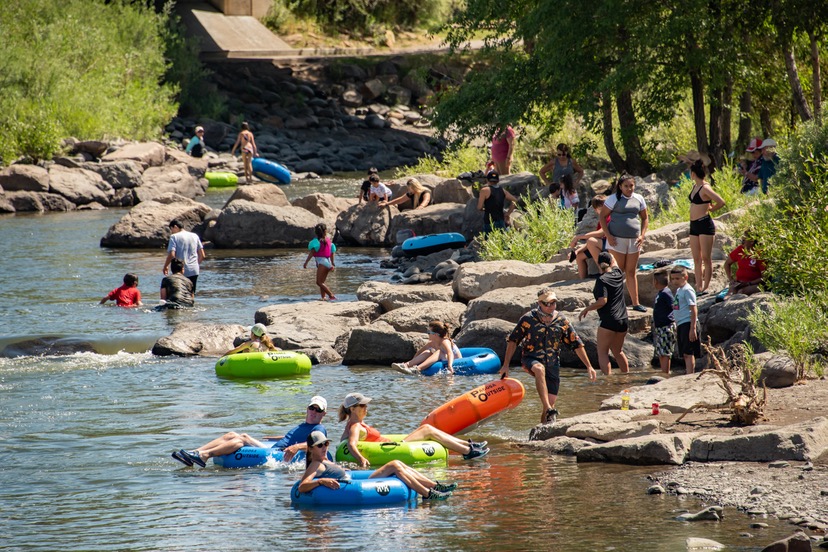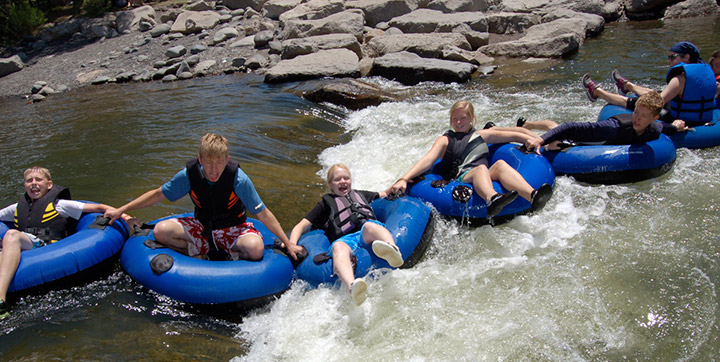People love to float in inner tubes down the San Juan River, in Pagosa Springs, Colorado. On any warm summer day, you can watch dozens of tubers drift past Town Park, under the Hot Springs Boulevard bridge, and on past the geothermally-heated soaking pools at the Springs Resort.
I have done it myself. But that would have been 25 years ago, when there might have been my family and one other family in the river, at any particular moment. The community had not yet invested hundreds of thousands of dollars into making the river friendly to tubers.
Times have changed.
What is less visible, during the summer months, are various forms of aquatic life that live under the water, and along the banks of the river. When we talk about ‘aquatic life’ most of us probably think first about ‘fish’ — one of the larger forms of aquatic life in the San Juan River. We might also consider ducks to be a form of aquatic life. But the most numerous lifeforms are plants and insects and worms and various smaller biological organisms that generally go unseen and unnoticed as we float down the river.
Of course, we could also think of “people” as a form of aquatic life. When we’re wearing swim suits.
As far as anyone can tell, the San Juan River has been populated by various biological organisms for at least the past 10,000 years, although the particular species may have varied with changing climatic conditions. People were one of the later arrivals. But people have had a major impact on the river, beyond merely tubing in the summer months. For one thing, people living in Pagosa Springs and visitors, many years ago, pretty much wiped out the native trout populations, and the trout that now reside in the river are nearly all the result of fish stocking efforts by local businesses, and governments, and Colorado Parks and Wildlife.
People also removed all the large rocks out of the river back in the 1920s, after the 1911 flood wiped out numerous bridges and destroyed some of the homes along Hermosa Street. Reportedly, people thought they could reduce flood damage by removing the boulders, and allowing the river to flow unimpeded during high water events.
That’s how the San Juan River looked when my family moved here in 1993. No large rocks. Kind of boring.
Not a lot of tubing was going on, back then. As I mentioned.
Starting in the 1990s, our local and state government began to collaborate on increasing the aquatic life in the river — mostly fish, and the bugs that fish eat — by adding boulders back into the river. The funding came mainly from the State of Colorado “Fishing is Fun” program.
Fish and bugs like boulders, it seems. In fact, I could suggest that all biological organisms thrive best, when a riverscape is diverse, and marked by surprising features. When the river is not boring.
That statement is not necessarily backed by scientific evidence.
The “Fishing is Fun” structures that were installed in the river may have made fishing more fun; I can’t comment on that, because I’d already given up fishing when this change took place. But the structures did not necessarily make rafting more fun. Occasionally, rafts would get hung up on the rock structures, causing consternation and inconvenient ‘rescue’ efforts.
Fishing should be fun. But rafting and tubing should also be fun. And certain Colorado mountain towns had seemingly figured out how to manage both outcomes. In particular, the City of Salida — population about 5,000 — had placed a lot of rocks in the downtown stretch of the Arkansas River, and cleverly created a ‘whitewater park’.
Some people from Pagosa visited Salida, and formed an instant appreciation for whitewater parks. “Hey, we could have this, too.”
So, back in 2005, the Town of Pagosa Springs began tearing out the state-funded “Fishing is Fun” structures, and creating its own “whitewater” features in the downtown stretch of the San Juan. Much of the work was donated by Davey Pitcher, president of Wolf Creek Ski Area, and owner of some heavy equipment suited to moving large boulders around.
16 years later, the downtown stretch of the San Juan looks rather different than it looked in 1993.
There’s a lot more aquatic life, for one thing. Especially in the summer.
Most forms of the aquatic life — the fish, bugs, worms, plants — stay in the river, and have a fine time. But the aquatic life known as “people” typically spend a couple of hours in the river, and then move to other locations. The streets and roads, for example. Vacation rentals. Restaurants. Hiking in the forest. Shopping in gift shops and second-hand stores. Sight-seeing.
After doing their utmost to impact the river as semi-aquatic organisms, the “people” escape, and proceed to impact the rest of Archuleta County.
If only we could keep them in the river…
That particular outcome — to keep people in the river as long as possible, and prevent them from overrunning the rest of our community — appears to be goal of a couple of local groups.
The Pagosa Springs Town Council… and the Upper San Juan Water Enhancement Partnership, more commonly known as “the WEP”.
Those two groups came together on Thursday, September 23, to discuss ways to spend millions of taxpayer dollars to keep people in the river. And to keep fish in the river, as well.
There’s a lot of taxpayer money available right now, it seems, to do exactly this kind of thing. More than we know what to do with.
As was mentioned, the various non-human forms of aquatic life have survived in the river for thousands of years. But they didn’t have to deal with humans. Certain human activities have made life more challenging, especially for the fish.
I’m thinking, here, of the high-performance fly rods currently available in sporting goods stores.
But life has also become more challenging for certain sectors of the human population in Pagosa Springs. I’m thinking, here, of two sectors in particular. Employees. And employers.
While the San Juan River has become an ever-more-popular destination, thanks to significant and ongoing investments of public money, other community needs have been hung out to dry, so to speak.
I wonder… if the people who are so intent upon keeping our aquatic life alive… will end up helping make the rest of the local human environment parched and lifeless?




